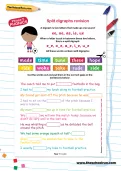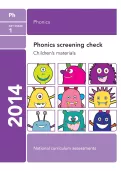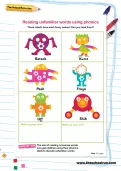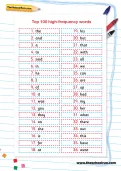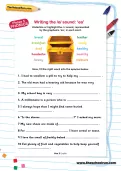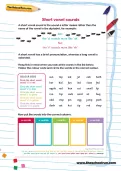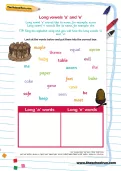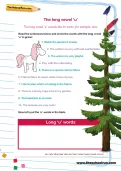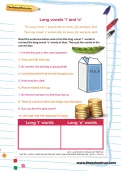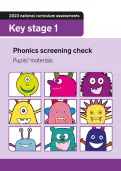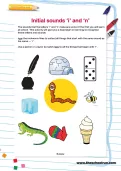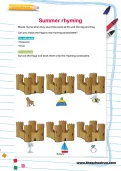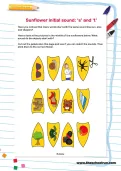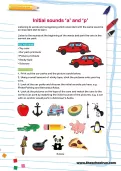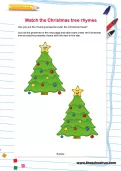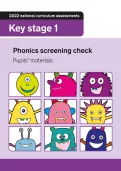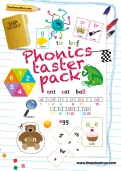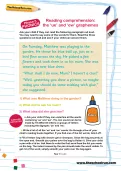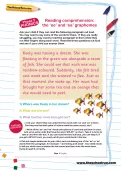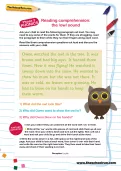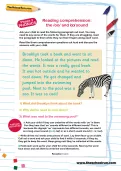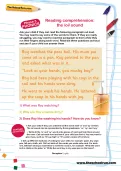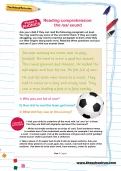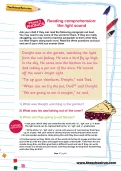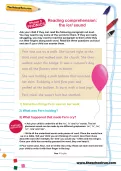A short vowel sound is pronounced for a shorter time than a long vowel sound. For instance, in the word fat, the vowel 'a' is short, but in fate, it's long. Use this worksheet to practise short vowel sounds and consolidate your child's phonics learning at home.
or
Register to add to your saved resources
A long vowel is pronounced for a longer time than a short vowel sound. In the word mat, the vowel 'a' is short, but in mate, it's long. Use this worksheet to practise the long vowel sounds 'a' and 'e' and consolidate your child's phonics learning at home.
or
Register to add to your saved resources
Long vowels are vowel sounds that are pronounced for a longer time than short vowels. In the word cut, the vowel 'i' is short, but in cute, it's long. Use this worksheet to practice the long vowel sounds 'u' and consolidate your child's phonics learning at home.
or
Register to add to your saved resources
Long vowels are vowel sounds that are pronounced for a longer time than short vowels. They can change the meaning of words. In the word bit, the vowel 'i' is short, but in bite, it's a long vowel sound. Use this worksheet to practice long vowel sounds 'i' and 'o' and consolidate your child's phonics learning at home.
or
Register to add to your saved resources
The Y1 Phonics screening check is used to test children's reading and phonics skills and what they've learnt in their first two years at school. Get an idea of what your child will be asked to do in the June test by looking through the official past paper for 2023.
or
Register to add to your saved resources
Iggy the inchworm likes to collect all things that start with the same sound as his name – ‘i’. Use a pencil or crayon to match Iggy to all the things that begin with ‘i’.
or
Register to add to your saved resources
Words rhyme when they sound the same at the end like dog and frog. Can you match the flags to the rhyming sandcastles?
or
Register to add to your saved resources
Have you noticed that many words start with the same sound like sun, star, and slippers? Have a look at these object and see if you recongise the sounds they start with, then cut out the petals and see if you can match the sounds.
or
Register to add to your saved resources
Listening to words and recognising which ones start with the same sound is an important skill to learn. Listen to the sounds at the beginning of the words and park the cars in the correct car park.
or
Register to add to your saved resources
Can you put the rhyming presents under the Christmas trees? Cut out the presents and stick them under the Christmas tree so that the presents rhyme with the item in the star.
or
Register to add to your saved resources
The Y1 Phonics screening check is used to test children's reading and phonics skills and what they've learnt in their first two years at school. Get an idea of what your child will be asked to do in the June test by looking through the official past paper for 2022.
or
Register to add to your saved resources
Introduce your child to phonics sounds with TheSchoolRun's FREE Phonics taster pack. You'll find phonics sounds mats and five games to play with Reception and Year 1 children, all designed to boost their confidence with phonics learning and help them practise their skills the fun way.
or
Register to add to your saved resources
A Year 1 teacher-created reading comprehension activity on the ‘ue’ and ‘ew’ graphemes in Phase 5 phonics.
or
Register to add to your saved resources
Already a subscriber? to view this content.
Practise the ‘ee’ and ‘ea’ graphemes with this reading comprehension – read the passage with your child and then ask them the questions that follow.
or
Register to add to your saved resources
Already a subscriber? to view this content.
Practise the /ow/ sound with this reading comprehension – read the passage with your child and then ask them the questions that follow.
or
Register to add to your saved resources
Already a subscriber? to view this content.
Practise spotting words with ‘oo’ in them with this reading comprehension. Read the passage with your child and then ask them the questions that follow.
or
Register to add to your saved resources
Already a subscriber? to view this content.
Practise the /oi/ sound with this reading comprehension – read the passage with your child and then ask them the questions that follow.
or
Register to add to your saved resources
Already a subscriber? to view this content.
Practise the /oa/ sound with this reading comprehension – read the passage with your child and then ask them the questions that follow.
or
Register to add to your saved resources
Already a subscriber? to view this content.
Practise the /igh/ sound with this reading comprehension – read the passage with your child and then ask them the questions that follow.
or
Register to add to your saved resources
Already a subscriber? to view this content.
Practise the /er/ sound with this reading comprehension – read the passage with your child and then ask them the questions that follow.
or
Register to add to your saved resources
Already a subscriber? to view this content.
